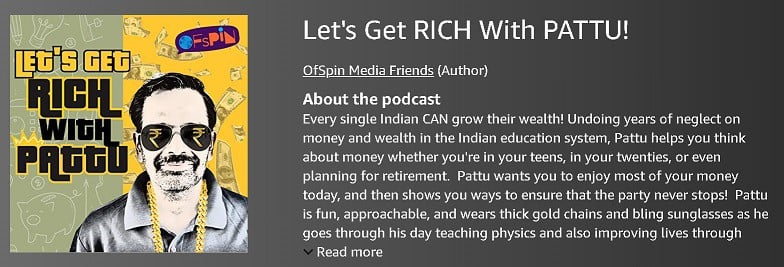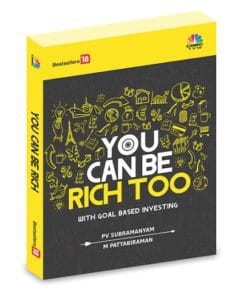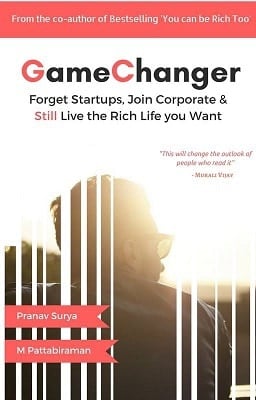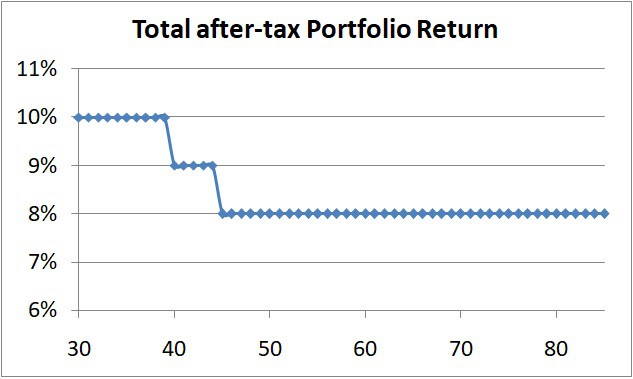Last Updated on December 29, 2021 at 5:13 pm
Sooner or later new mutual fund or direct equity investors recognise that the long term India story or the long term equity stories need not always reflect in individual returns. After either prolonged losses or after understanding that one cannot expect returns from mutual fund SIPs! (Do this instead!) and how investors get fooled into buying mutual funds with wrong expectations, many ask, “if after a long time I am only going to get 10% or less (no guarantees!) before tax with so much risk, why not use EPF plus PPF alone for retirement planning?“ Let us find out in this post.
Another important lesson is the biggest risk in the stock market is not a deep crash but years and years of sideways movement. See for example: How can a 400% profit result only in 8% return?! Hodling to the moon Risk!
Short Answer: In principle, it is possible to plan for retirement with EPF + PPF alone without equity. However, there are many assumptions involved (some unrealistic), and not everyone can pull this off. Even those who can pull it off are taking a bigger risk by avoiding equity.
What are the advantages of EPF and PPF? Although EPF and PPF rates have gone down over the last three decades, there is still a huge disparity between “officially reported” inflation numbers and how these rates are fixed. It should be obvious political considerations determine the rate and not economic.
Join 32,000+ readers and get free money management solutions delivered to your inbox! Subscribe to get posts via email! (Link takes you to our email sign-up form)
🔥Want to create a complete financial plan? Learn goal-based investing? Exclusive access to our DIY tools? Increase your income with your skills? Enjoy massive discounts on our robo-advisory tool & courses! 🔥
With most of the population used to a sense of entitlement thanks to years and years of sops and subsidies, it would be hard for the government (although it is trying) to drop and/or vary these rates by a big amount.
Both EPF and PPF (if started early on) support early retirement (defined as at an age less than age 58 or 60), unlike NPS. See: EPF vs NPS: Should you shift to NPS because the govt wants you to?
Both EPF and PPF are EEE instruments will full tax-free withdrawals. With 80C automatically taken care of by these, EPF (via VPF) has no restrictions on maximum investment. This will offset the 1.5 Lakh a year limit set by PPF.
A couple with single or double income can operate two PPF accounts making this limit effectively three lakhs. Also see: How much can we invest in multiple PPF accounts?
A PPF account can be held life-long with or without contributions. Both have different withdrawal limits. See: Public Provident Fund (PPF) Extension Rules Upon Maturity
We shall assume the entire post-retirement corpus will be managed with PPF + small saving schemes to ensure 8% (tax-free or post-tax return for life).
What are the assumptions necessary while using only EPF + PPF? The list is long, some qualitative and some quantitative. Readers are urged to pay close attention to each.
- Availability of a large emergency fund throughout the lifetime. At least until retirement, it will be supported from income.
- The current health insurance premium is part of annual expenses. If one does not have personal health insurance, then it is better to buy one or at least account for its current expense in the current annual expenses. Helpful resources: This free ebook on Health Insurance will help you choose a policy with ease! Also see: Health Insurance Policy Comparison Spreadsheet
- The inflation assumed throughout a lifetime is 6-8%. Realistic personal inflation numbers could be higher. Use this tool to check: Personal Inflation Calculator. If one argues that inflation will lower with age, the constant 8% return from EPF/PPF (see next point) will also not hold. Also, do not assume your expenses will decrease after retirement! A single disease like diabetes or heart-related ailments can be disastrous.
- The EPF and PPF rate is assumed to 8% a year until retirement. This is not realistic, but we will work with it to see what we get. Also see: The evolution of Public Provident Fund (PPF) Interest Rates
- The projections shown below are based on current expenses that will persist in retirement. Please recognise that it does not account for the cost of buying a new mobile or laptop every five years or other electronic appliances. Unless you repeat the calculation each year, it will not account for changes in lifestyle that add to the expenses that will persist in retirement.
- Post-retirement after-tax return is assumed to be 8%. This is too hard to pull off.
Before we begin, please answer this question
Regardless of whether you pay tax on the annual income or not, would you rather retire in the 5% or 0% tax slab or in the 20% or 30%? That is should your (potential) annual income be 5 Lakh or 15 Lakh?
Retirement Planning with EPF and PPF
Illustration 1 (6% inflation)
This is a tabulation with about 2% returns (after) above inflation!! We are considering a 30-year old retiring at 50 and hopes to live until age 85. Considering the current work culture, most people will not or cannot work beyond 50. Age 60 cannot be used as the retirement age for a 30-something in 2019. They may either die before that or worse be too sick for gainful employment.
The year-end retirement corpus grows year on year at 8%. After age 50 withdrawals equal to annual expenses are made from it. This is why it goes to zero at age 85 (and hopefully not before!).
Notice that the annual investment is pretty equal to annual expenses even with 2% real return!! How many can this pull this off? Remember we have not accounted for the present and future needs of children. Not accounted for EMIs!!
| Age | Annual Expenses | Annual investment for retirement | Total Portfolio Return | Corpus (year-end) |
| 30 | 4,00,000 | 3,99,522 | 8% | 4,31,484 |
| 31 | 4,24,000 | 4,23,493 | 8% | 9,23,375 |
| 32 | 4,49,440 | 4,48,903 | 8% | 14,82,061 |
| 33 | 4,76,406 | 4,75,837 | 8% | 21,14,530 |
| 34 | 5,04,991 | 5,04,387 | 8% | 28,28,431 |
| 35 | 5,35,290 | 5,34,651 | 8% | 36,32,128 |
| 36 | 5,67,408 | 5,66,730 | 8% | 45,34,766 |
| 37 | 6,01,452 | 6,00,734 | 8% | 55,46,340 |
| 38 | 6,37,539 | 6,36,778 | 8% | 66,77,767 |
| 39 | 6,75,792 | 6,74,984 | 8% | 79,40,971 |
| 40 | 7,16,339 | 7,15,483 | 8% | 93,48,970 |
| 41 | 7,59,319 | 7,58,412 | 8% | 1,09,15,973 |
| 42 | 8,04,879 | 8,03,917 | 8% | 1,26,57,482 |
| 43 | 8,53,171 | 8,52,152 | 8% | 1,45,90,404 |
| 44 | 9,04,362 | 9,03,281 | 8% | 1,67,33,180 |
| 45 | 9,58,623 | 9,57,478 | 8% | 1,91,05,911 |
| 46 | 10,16,141 | 10,14,927 | 8% | 2,17,30,504 |
| 47 | 10,77,109 | 10,75,822 | 8% | 2,46,30,833 |
| 48 | 11,41,736 | 11,40,372 | 8% | 2,78,32,901 |
| 49 | 12,10,240 | 12,08,794 | 8% | 3,13,65,030 |
| 50 | 12,82,854 | 12,81,322 | 8% | 3,52,58,060 |
| 51 | 13,59,825 | 8% | 3,66,10,093 | |
| 52 | 14,41,415 | 8% | 3,79,82,172 | |
| 53 | 15,27,900 | 8% | 3,93,70,614 | |
| 54 | 16,19,574 | 8% | 4,07,71,124 | |
| 55 | 17,16,748 | 8% | 4,21,78,725 | |
| 56 | 18,19,753 | 8% | 4,35,87,690 | |
| 57 | 19,28,938 | 8% | 4,49,91,452 | |
| 58 | 20,44,675 | 8% | 4,63,82,519 | |
| 59 | 21,67,355 | 8% | 4,77,52,377 | |
| 60 | 22,97,396 | 8% | 4,90,91,379 | |
| 61 | 24,35,240 | 8% | 5,03,88,630 | |
| 62 | 25,81,355 | 8% | 5,16,31,857 | |
| 63 | 27,36,236 | 8% | 5,28,07,271 | |
| 64 | 29,00,410 | 8% | 5,38,99,410 | |
| 65 | 30,74,435 | 8% | 5,48,90,973 | |
| 66 | 32,58,901 | 8% | 5,57,62,638 | |
| 67 | 34,54,435 | 8% | 5,64,92,859 | |
| 68 | 36,61,701 | 8% | 5,70,57,651 | |
| 69 | 38,81,403 | 8% | 5,74,30,348 | |
| 70 | 41,14,287 | 8% | 5,75,81,346 | |
| 71 | 43,61,144 | 8% | 5,74,77,817 | |
| 72 | 46,22,813 | 8% | 5,70,83,405 | |
| 73 | 49,00,182 | 8% | 5,63,57,881 | |
| 74 | 51,94,193 | 8% | 5,52,56,783 | |
| 75 | 55,05,844 | 8% | 5,37,31,014 | |
| 76 | 58,36,195 | 8% | 5,17,26,404 | |
| 77 | 61,86,367 | 8% | 4,91,83,240 | |
| 78 | 65,57,549 | 8% | 4,60,35,747 | |
| 79 | 69,51,002 | 8% | 4,22,11,525 | |
| 80 | 73,68,062 | 8% | 3,76,30,941 | |
| 81 | 78,10,145 | 8% | 3,22,06,459 | |
| 82 | 82,78,754 | 8% | 2,58,41,921 | |
| 83 | 87,75,479 | 8% | 1,84,31,757 | |
| 84 | 93,02,008 | 8% | 98,60,129 | |
| 85 | 98,60,129 | 8% | 0 |
Illustration 2 (7% inflation)
If inflation is increased to 7%, the annual investment become 129% of annual expenses!!
Illustration 3 (8% inflation)
If inflation is increased to 8%, the annual investment become 167% of annual expenses!!
Let us now include some equity exposure so that after-tax portfolio return over the years looks like this.
Illustration 4 (6% inflation with equity exposure as above)
The annual investment drops from 100% to 91%. of annual expenses. This is a cumulative saving of 13.7 lakhs over the next 20 years! Even this 91% will be hard for many to pull off!
Summary
Investors who invest in equity and embrace daily volatility and learn how to manage it can invest significantly less for retirement. The investment risk is guaranteed but is eminently manageable given enough time.
Investors who want to stay away from all market-linked returns (although PPF and EPF are also weakly market-linked) will have to pay a different price. In this case, the investment amount will be higher. This the guaranteed risk here and is a lot harder to manage given the needs of children, EMIs and other unexpected expenses. Using EPF and PPF, one will have to work for the designated term (assumed while planning, 50 here) and cannot quit earlier. This is a risk in case health issues intervene.
When the investment budget is rigid (in the case of EPF + PPF with no equity), one cannot accommodate additional expenses that are either good or bad needs and wants.
Whether we choose to avoid the stock market or not, every option, every choice has an associated risk. It is only a question of which is more acceptable and which is more manageable.
Would you instead combat stock market volatility or combat your monthly budget to avoid market risk?
🔥Enjoy massive discounts on our courses, robo-advisory tool and exclusive investor circle! 🔥& join our community of 7000+ users!
Use our Robo-advisory Tool for a start-to-finish financial plan! ⇐ More than 2,500 investors and advisors use this!
Track your mutual funds and stock investments with this Google Sheet!
We also publish monthly equity mutual funds, debt and hybrid mutual funds, index funds and ETF screeners and momentum, low-volatility stock screeners.





- Do you have a comment about the above article? Reach out to us on Twitter: @freefincal or @pattufreefincal
- Have a question? Subscribe to our newsletter using the form below.
- Hit 'reply' to any email from us! We do not offer personalized investment advice. We can write a detailed article without mentioning your name if you have a generic question.
Join 32,000+ readers and get free money management solutions delivered to your inbox! Subscribe to get posts via email! (Link takes you to our email sign-up form)
About The Author
 Dr M. Pattabiraman(PhD) is the founder, managing editor and primary author of freefincal. He is an associate professor at the Indian Institute of Technology, Madras. He has over ten years of experience publishing news analysis, research and financial product development. Connect with him via Twitter(X), Linkedin, or YouTube. Pattabiraman has co-authored three print books: (1) You can be rich too with goal-based investing (CNBC TV18) for DIY investors. (2) Gamechanger for young earners. (3) Chinchu Gets a Superpower! for kids. He has also written seven other free e-books on various money management topics. He is a patron and co-founder of “Fee-only India,” an organisation promoting unbiased, commission-free investment advice.
Dr M. Pattabiraman(PhD) is the founder, managing editor and primary author of freefincal. He is an associate professor at the Indian Institute of Technology, Madras. He has over ten years of experience publishing news analysis, research and financial product development. Connect with him via Twitter(X), Linkedin, or YouTube. Pattabiraman has co-authored three print books: (1) You can be rich too with goal-based investing (CNBC TV18) for DIY investors. (2) Gamechanger for young earners. (3) Chinchu Gets a Superpower! for kids. He has also written seven other free e-books on various money management topics. He is a patron and co-founder of “Fee-only India,” an organisation promoting unbiased, commission-free investment advice.Our flagship course! Learn to manage your portfolio like a pro to achieve your goals regardless of market conditions! ⇐ More than 3,000 investors and advisors are part of our exclusive community! Get clarity on how to plan for your goals and achieve the necessary corpus no matter the market condition is!! Watch the first lecture for free! One-time payment! No recurring fees! Life-long access to videos! Reduce fear, uncertainty and doubt while investing! Learn how to plan for your goals before and after retirement with confidence.
Our new course! Increase your income by getting people to pay for your skills! ⇐ More than 700 salaried employees, entrepreneurs and financial advisors are part of our exclusive community! Learn how to get people to pay for your skills! Whether you are a professional or small business owner who wants more clients via online visibility or a salaried person wanting a side income or passive income, we will show you how to achieve this by showcasing your skills and building a community that trusts and pays you! (watch 1st lecture for free). One-time payment! No recurring fees! Life-long access to videos!
Our new book for kids: “Chinchu Gets a Superpower!” is now available!


Must-read book even for adults! This is something that every parent should teach their kids right from their young age. The importance of money management and decision making based on their wants and needs. Very nicely written in simple terms. - Arun.Buy the book: Chinchu gets a superpower for your child!
How to profit from content writing: Our new ebook is for those interested in getting side income via content writing. It is available at a 50% discount for Rs. 500 only!
Do you want to check if the market is overvalued or undervalued? Use our market valuation tool (it will work with any index!), or get the Tactical Buy/Sell timing tool!
We publish monthly mutual fund screeners and momentum, low-volatility stock screeners.
About freefincal & its content policy. Freefincal is a News Media Organization dedicated to providing original analysis, reports, reviews and insights on mutual funds, stocks, investing, retirement and personal finance developments. We do so without conflict of interest and bias. Follow us on Google News. Freefincal serves more than three million readers a year (5 million page views) with articles based only on factual information and detailed analysis by its authors. All statements made will be verified with credible and knowledgeable sources before publication. Freefincal does not publish paid articles, promotions, PR, satire or opinions without data. All opinions will be inferences backed by verifiable, reproducible evidence/data. Contact information: To get in touch, use this contact form. (Sponsored posts or paid collaborations will not be entertained.)
Connect with us on social media
- Twitter @freefincal
- Subscribe to our YouTube Videos
- Posts feed via Feedburner.
Our publications
You Can Be Rich Too with Goal-Based Investing
 Published by CNBC TV18, this book is meant to help you ask the right questions and seek the correct answers, and since it comes with nine online calculators, you can also create custom solutions for your lifestyle! Get it now.
Published by CNBC TV18, this book is meant to help you ask the right questions and seek the correct answers, and since it comes with nine online calculators, you can also create custom solutions for your lifestyle! Get it now.Gamechanger: Forget Startups, Join Corporate & Still Live the Rich Life You Want
 This book is meant for young earners to get their basics right from day one! It will also help you travel to exotic places at a low cost! Get it or gift it to a young earner.
This book is meant for young earners to get their basics right from day one! It will also help you travel to exotic places at a low cost! Get it or gift it to a young earner.Your Ultimate Guide to Travel
 This is an in-depth dive into vacation planning, finding cheap flights, budget accommodation, what to do when travelling, and how travelling slowly is better financially and psychologically, with links to the web pages and hand-holding at every step. Get the pdf for Rs 300 (instant download)
This is an in-depth dive into vacation planning, finding cheap flights, budget accommodation, what to do when travelling, and how travelling slowly is better financially and psychologically, with links to the web pages and hand-holding at every step. Get the pdf for Rs 300 (instant download)